As a special thanks to fxinsider members, we’re going behind the scenes of the VES Awards nominees in the ‘Outstanding Models in a Feature Motion Picture’ category. Below you’ll find links to our previous coverage of The Avengers, The Impossible and Men In Black 3, plus we also have an in-depth interview with New Deal Studios on their work for The Dark Knight Rises, focusing on the nominated plane heist sequence.
VES Award nominees for ‘Outstanding Models in a Feature Motion Picture’
The Avengers: Helicarrier – Rene Garcia, Bruce Holcomb, Polly Ing, Aaron Wilson
The Impossible: Orchid Hotel – Markus Donhauser, Patrick Lehn, Angel Martinez, Juergen Pirman
Men in Black 3: Cape Canaveral/ Apollo Launch – Craig Feifarek, Hee-Chel Nam, Erik Neill, Taehyun Park
The Dark Knight Rises: Airplane Heist – Scott Beverly, Alan Faucher, Ian Hunter, Steve Newburn (see below)
How to rip off wings (for real): New Deal Studios and The Dark Knight Rises
Having contributed the hospital explosion in Christopher Nolan’s Inception, and key Tumbler and miniature effects to The Dark Knight, New Deal Studios already had a proven track record with the director. And so when The Dark Knight Rises visual effects producer Mike Chambers and overall VFX supervisor Paul Franklin asked New Deal to work on the third Nolan Batman film, the studio of course obliged. We talk to New Deal’s visual effects supervisor Ian Hunter about their two sequences for TDKR – Bane’s plane hijacking and his underground attack on Applied Sciences.
The plane hijacking

In a plot to destroy Gotham via a thermonuclear weapon, mercenary Bane and his men commandeer a government plane – an Embraer Bandeirante – then kidnap a Russian nuclear scientist who had been under the care of CIA agents. The mercenaries are then taken away via another aircraft, a C-130 Hercules. This action piece was remarkable for two reasons: it was filmed in IMAX and it was also shown as a six minute prologue attached to 70mm IMAX prints of Mission: Impossible – Ghost Protocol, seven months before The Dark Knight Rises was released. A combination of real planes, stunt photography, digital work by Double Negative and miniature effects from New Deal Studios helped realize the daring sequence.
New Deal came in specifically for the shot of the Embraer flipping over and having its wings and tail torn off after the C-130 has been used to hook cables to the smaller plane. Production filmed a real C-130 and Embraer flying over Scotland, plus plates of the C-130 by itself. “They gave us those pieces,” outlines New Deal visual effects supervisor Ian Hunter, “and we matched the movement back into the Embraer based on the placement of the C-130. We went into Maya and tracked those movements in and used a 3D model of a Technocrane to previs the shot. It wasn’t motion control per se but it was something we could start with a beginning and an end and define the movement with a Technocrane. Once we got those movements in Maya, we also modeled our shooting space, our backlot, and put in greenscreen there. So we previs’d all the movements we needed for the model and camera beforehand – and based on that we started laying out what would be done with the model.”
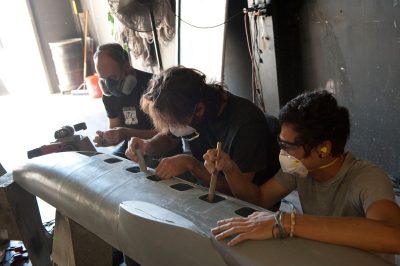
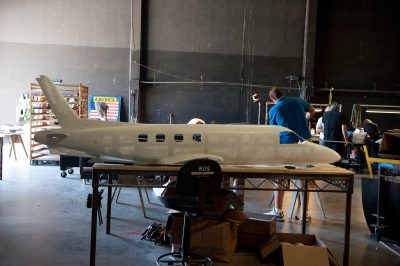
Fifth-scale was chosen for the Embraer. “We got a 3D model from Double Negative, plus we went online and got drawings of the Embraer and between the two we created a new version in Rhino3D,” says Hunter. “It pretty much matched the DNeg model, but for engineering purposes we made a new 3D model in Rhino. We had urethane foam cuts and CNC cuts based on those models – the idea being that our physical model and DNeg’s digi-model are pretty much one-on-one.”
After the CNC parts were cut from urethane, New Deal detailed the patterns and made molds and two fiberglass Embraer airplanes. “The amount of hand work in terms of the fabrication was less than on say The Aviator,” says Hunter. “The Spruce Goose in that film was hand made but the wings were laser cut ribs that were skinned, so there’s a different degree of techniques used there.”

“The actual models were straightforward epoxy fiberglass shells, as they were on Aviator,” adds Hunter. “We laid in a very thin coat of resin into the mold where the break was going to occur. We backed it with layers of metal foil tape and that’s the actual part we use for where the wings sheer apart – it allows us to put in detail which is incorporated into the mold but it has that backing, so when it comes apart it looks like metal, because it is metal. The technique goes all the way to Pitch Black.”
The two Embraer models were built with pre-cut and pre-scored wings to come apart at specific points. “The wings are pinned together and there’s a detonator holding the wings,” says Hunter, “but the way the timing works, you actually have to start using the pneumatics to start pulling before you actually pop the pyrotechnics. So it’s down to the thousandths of a second, because by the time the cable’s starting to pull, the slack is starting to come out. So that’s when we had to cut the wings with the pyrotechnics. The pyro works so fast that they actually fire after the pneumatics start to fire.”

The interiors of the Embraers were fashioned from the full-sized plane set, although it was in actual fact two and a half times the real size, resulting in a few augmentations to the miniatures. For pilots, New Deal fashioned figures from Justin Bieber dolls. “We put them in little uniforms and stuck them in the cockpits,” exclaims Hunter. “They’re very hard to see but they’re there!”
In the sequence, Bane, the scientist and some of his men are lifted out of the wingless Embraer, attached by lines to the C-130. One hapless mercenary is forced to stay behind with the deceased agents. In Scotland, a helicopter carried a full-sized Embraer fuselage and dropped it to the ground. This gave New Deal practical footage to match to. Also, the shot was based off of previs that DNeg had provided, which meant there needed to be specific frames where the airplane would flip over. “We could actually pick those frames and program our timing box to pull the pneumatics at the right moment to pull the wings off,” explains Hunter.
The miniature planes were flown on a trapeze system – a set of wires hung from a simple aluminum frame. “We had one piston controlling the rotation of the plane, the main piston, and then we had two pistons per wing,” says Hunter. “The outside part of the wing and then the wing against the fuselage pulled off on separate cables, and then off of each cable we had monofilament running out to things like the elevators, aerolons and major pieces of the wings. The major pieces could be guided back the right way.”
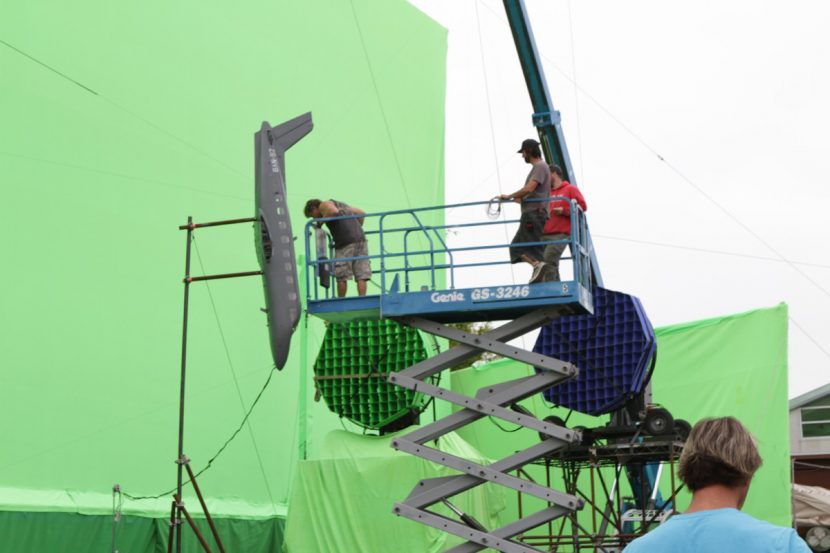
To film the flip, New Deal set the models outside on their former backlot and placed two ritter fans with greenscreen-painted baffles in front of the airplanes to ensure the debris and smoke would come away in the right direction. The sequence was shot on VistaVision cameras at 72 frames per second on a Technocrane and another crane mounted up higher in a Condor lift. The wings shoot required two takes shot over two days. “Even though we did two takes for the wings,” says Hunter, “I believe it was the first take that ended up in the movie. Rare, because the only other time we’ve had that happen is back on Dark Knight when we did the garbage truck being crashed by the Batmobile.”
Using VistaVision cameras allowed the filmmakers to blow up the negative to comp the effect into the Scotland plates so it would hold up for IMAX. “The only VistaVision cameras you can get now that have high speed capability only go up to 72 frames per second,” notes Hunter, “so we built the models in the fifth scale so they’d be large enough to be correct at the frame rate we were going at.”

During the actual flip, there was a gap between the moment the Embraer begins to nose down, and when the wings come off, so Hunter suggested that the engines should burn out. “At that point,” he says, “we actually put little flame charges in the exhaust pipes of the plane, so as it flips over just before the wings come off, it gives us a little burst as if the engines have burnt through.”
“We had a specific position the camera would come to that would trigger the rotation,” says Hunter. “So in that case, the timing was automatic. When it came to shearing the tails off, it was a visual thing and more crude – we would rehearse the move and literally use a grease pencil to mark the monitor where the model was supposed to be. What’s deceptive is that when we press the button and the sequence starts, the rotation starts, so no pyro, all we see is the rotation, you have to wait a second and a half before the wings would sheer off.”
Each of the wing joints were packed with small pieces of black wrap and plastic model parts so that when they broke there were parts flying out. “The final touch was that,” says Hunter, “was as the wings were sheering off we put little pieces full of A-B smoke in there, which had another charge on them, so that when the wings came off there’s a little burst of fuel and fluid coming out of the wings. Chris Nolan didn’t want to see flames come off – he wanted it to be a physical thing, as if turbulence had ripped them apart as opposed to actual pyrotechnics. So it was really important to them the wings not be removed with explosives.”
On a third day, the leftover miniature Embraer fuselages were hung on wires for shots of their tails coming off. “This was supposed to look like it had been done with explosives,” says Hunter. “There were charges put on by Bane’s men, so we were allowed a little bit of flames. We put wind on it, then we used a pneumatic cylinder along with pulling a cable along with pyrotechnics to sheer the tails off.”
Bane’s underground attack
Having completed ‘Phase One’ of the miniature effects for The Dark Knight Rises with the plane hijacking, New Deal was then called upon for shots of Bane’s underground attack. Here, Bane and his men have been mining under the city in the subterranean sewer system. Eventually it is revealed that they are burrowing underneath Wayne Enterprises’ Applied Sciences – where much of Batman’s high-tech weaponry is stored, including versions of the Tumbler.
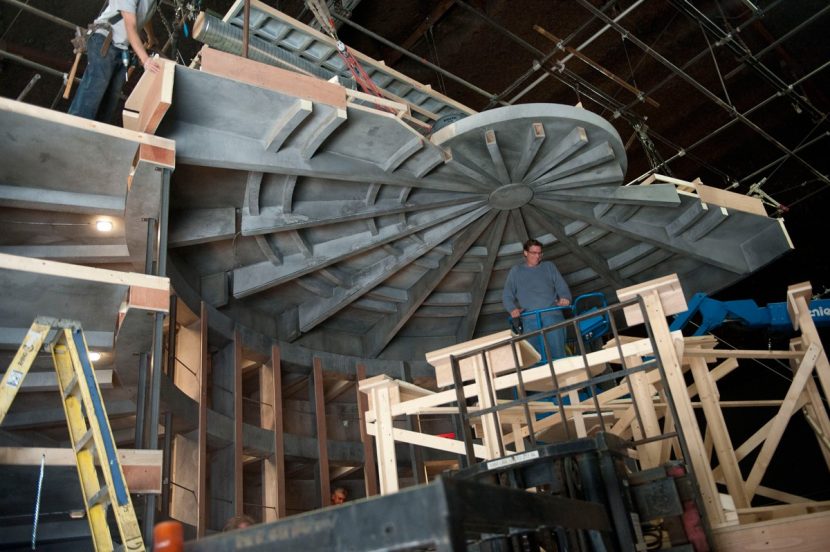
With charges laid in the ceiling of this ‘lair’ – which is also the floor of Applied Sciences – Bane blows into the storage area, enabling his men to crawl up and steal the weapons. New Deal realized the explosion and several surrounding shots. “We had to match a set they built in Cardington in England,” says Hunter, “a really large full-size 4 to 5 story tall set. It was the bottom of Bane’s lair, and it was plumbed with water spraying in there and everything. The real set needed to be 10 or 12 stories tall, and they didn’t have the room, so we helped with extensions.”
The Applied Sciences set was actually a parking lot at the LA Convention Center, and the miniature lair effects, built in third scale, were aimed at bridging the Cardington and car park environments. In addition, New Deal created a miniature camouflage-covered Tumbler vehicle to fall into the lair as a result of the explosion. “Our old friend the 20 foot container containing all the Batmobile parts came from England and so parts of that car have been in all three movies,” says Hunter. “We pulled body parts from one of the stunt cars from Dark Knight – and we made a chassis and built a new hybrid of new chassis and old body parts.”
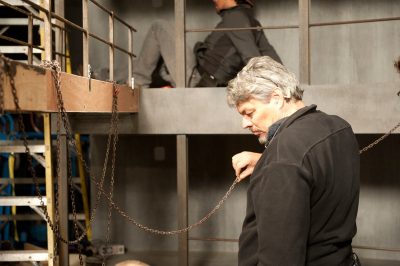
The lair pieces were made from lumber and MDF, with the ceiling rendered in stacked rigid urethane foam. “This was made up of a lot of puzzle pieces and reassembled to fit,” says Hunter. “We use these pieces of plastic to bridge the gaps between the puzzle pieces, and then in each of the seams we put a detonator so we could cut them into sections. Once the ceiling broke through, you saw the hole and people crawling through it, so we shot the model as a background plate and stuntmen against greenscreen and DNeg comp’d them together.”
New Deal built not only the ceiling, but also above Bane’s lair set was another model of the floor of the Convention Center. “We built a matching piece of that in scale,” comments Hunter, “so that when the ceiling of Bane’s lair falls through you can see the hole – the Applied Sciences set. The actual explosives, the charges, were like primacord going off, which was an aesthetic look.Then we had real pyrotechnics going off in the ceiling that broke it apart, so we could have the car fall through.”
A full-sized Tumbler had been filmed crashing in Cardington, but because of the camera angle and the fact that there was no ceiling to drop it through, the shot was deemed a model shoot. “We built the floor section of Bane’s lair to match their set in England,” says Hunter, “and dropped our car into it, and it was covered with a steel grid – walkway. In order to get that to crush, we made a mold of a pattern of that. We made some flexible resin floor grids with wire inside them so when the car crashed down it would actually bend and distort like metal, as opposed to breaking like plastic.”

“The car itself was on a trip,” says Hunter. “We would suspend the car about a foot above the ceiling that was breaking up. We had the aesthetic zip cord that was running up the set that gave us the splash of light that made it look like the primacord was going off – then we had actual detonators breaking the ceiling above, and we dropped the car. That was very carefully timed and tested so we could get the car to come through. We didn’t want to have the ceiling fall away before the car fell through – on the other hand we didn’t want to have the car land before the ceiling before it broke.”
“We actually put a cable through the bottom of the car so that when it fell we could put tension on it so it wouldn’t bounce back up,” adds Hunter. “Between the garbage truck and the way the Tumbler fell and crashed through the floor, it’s as if it’s made from Plutonium or something! It’s really heavy!”

As the location was supposed to be a sewer system, water was required to run constantly. Scott Beverly, who had also engineered the plane shots and Tumbler crash, plumbed the miniature set with special fine misting sprinkler heads. “At third scale they worked really well to have water running with fine mist,” says Hunter. “They liked the mist so much that they wanted a POV of Batman looking up through this hole and so we put our camera down there and operated it by hand and let the rain hit the lens to make it look like it’s him looking up at this set. It’s a nice in-camera shot of our third scale model, with a little more use out of it.”
The explosion shots were filmed on VistaVision at 60 frames per second, shoehorned into New Deal’s former stage at Marina Del Ray. “We literally had to put the Applied Sciences ceiling up against our ceiling of our stage,” notes Hunter, “and then we had these really annoying reinforcing rods across the stage that hold the building together. The car was above those rods. Normally we build below that, but for third scale we had to do it that way.”
Hunter adds: “The funny thing was that at no time between the live action and our sets do you actually see the whole height of the lair – it’s always implied. In miniature we couldn’t built the full ten stories, so we built six stories and another three stories for when it hits the floor. Those were shot separately and conveniently there’s a bridge that cuts across the scene and they could editorially bridge the two together.”
All images and clips copyright Warner Bros. Pictures 2012.

Fantastic!